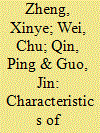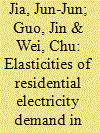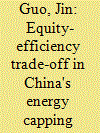|
|
|
Sort Order |
|
|
|
Items / Page
|
|
|
|
|
|
|
| Srl | Item |
| 1 |
ID:
136208


|
|
|
|
|
| Summary/Abstract |
A comprehensive survey of 1450 households in 26 Chinese provinces was undertaken in 2012 to identify the characteristics and potential driving forces of residential energy consumption in China. The survey covers six areas: household characteristics, dwelling characteristics, kitchen and home appliances, space heating and cooling, residential transportation, and electricity billing, metering, and pricing options. The results show that a typical Chinese household in 2012 consumed 1426 kilograms standard coal equivalent, which is approximately 44 percent of the 2009 level in the United States and 38 percent of the 2008 level in the EU-27. District heating, natural gas, and electricity are three major residential energy sources, while space heating, cooking, and water heating are three major end-use activities. Moreover, the results suggest a large urban–rural gap in terms of energy sources and purpose of usage. Commercial energy is used mainly for space heating in urban areas, while biomass dominates mainly for cooking purpose in rural areas. The survey results can help decision makers and scholars identify energy conservation opportunities, and evaluate the effectiveness of energy policies.
|
|
|
|
|
|
|
|
|
|
|
|
|
|
|
|
| 2 |
ID:
150720


|
|
|
|
|
| Summary/Abstract |
China’s residential electricity demand has grown rapidly over the last three decades and given the expected continued growth, demand side management (DSM) can play an important role in reducing electricity demand. By using micro-level data collected from 1450 households in 27 provinces in the first-ever China Residential Energy Consumption Survey in 2012, this study estimates the effects of three DSM measures empirically: tiered household electricity pricing, China Energy Label program, and information feedback mechanisms. We find these measures have contributed to moderating residential electricity demand growth but additional policy reform and tools are needed to increase their effectiveness and impact. Residential electricity demand is found to be price- and income- inelastic and tiered pricing alone may not be as effective in electricity conservation. The statistically significant relationship between China Energy Label efficient refrigerators - but not televisions - and lowered residential electricity consumption reflect mixed program effectiveness. Lastly, of the information feedback currently available through electricity bills, payment frequency and meters, only meter reader is estimated to be statistically significant. Important policy implications and recommendations for improving each of these three DSM measures to expand their impact on reducing residential electricity consumption are identified.
|
|
|
|
|
|
|
|
|
|
|
|
|
|
|
|
| 3 |
ID:
179683


|
|
|
|
|
| Summary/Abstract |
China has implemented the residential increasing-block electricity pricing (IBEP) policy since the second half of 2012, which is considered the most effective economic instrument in improving residential energy efficiency. Price and income elasticity are two fundamental parameters to guide both scholars and policy-makers in assessing whether and to what extend Chinese households respond to the policy. However, it presents the challenge of simultaneous determination of marginal price and electricity consumption; further, it is less examined from an empirical perspective due to the absence of micro-level data. To fill this gap, this study estimates price and income elasticity by establishing two instrumental variables, based on a unique dataset from the Chinese Residential Energy Consumption Survey 2014. Results show that the residential demand for electricity is price inelastic and that electricity is an essential commodity for households in the short run. It also shows great urban-rural disparity and regional heterogeneity of household electricity consumption behavior regarding short-run income elasticity. The estimated parameters of short-run price and income elasticities provide a valuable reference for policy-making regarding both a nationwide uniform and a differential regional perspective.
|
|
|
|
|
|
|
|
|
|
|
|
|
|
|
|
| 4 |
ID:
163538


|
|
|
|
|
| Summary/Abstract |
As a part of the transition to a sustainable economy, China has set a cap on primary energy consumption for the first time, of 5.0 billion tonnes of standard coal equivalent by 2020. However, there is a debate on the cap feasibility and failure to adequately address the underlying equity-efficiency trade-off, which hampers achievement. This paper identifies some key challenges ahead, including the coal-dominant energy mix, declining financial support, inconsistent central-local goals, rising costs of energy-saving measures and quality of energy statistical data. By quantifying the preference of each providence toward equity-based or efficiency-based allocation schemes, the great disparity among provinces is revealed and the equity-efficiency trade-off relationship is confirmed. Developing regions, primarily located in central and western areas, tend to favor equity-based disaggregating schemes. Contrarily, developed coastal provinces strongly favor efficiency-based schemes. The present national disaggregation schemes are mainly based on historical energy consumption, but disregard the provincial development gap and efficiency factors. We conclude that this ambitious goal is likely within reach, but increased efforts and flexible instruments are needed.
|
|
|
|
|
|
|
|
|
|
|
|
|
|
|
|
| 5 |
ID:
150637


|
|
|
|
|
| Summary/Abstract |
In recent years, there has been a fast-growing body of literature examining energy-saving potential in relation to electricity. However, empirical studies focusing on non-Western nations are limited. To fill this gap, this study intends to examine the electricity-saving potential of rural households in China using a unique data set from the China Residential Electricity Consumption Survey (CRECS) in collaboration with the China General Social Survey (CGSS), conducted nationwide at the household level in rural China. We use a stochastic frontier model, which allows us to decompose residential electricity consumption into the minimum necessary amount of consumption based on physical characteristics (e.g. house size, house age, number of televisions or refrigerators) and estimate the consumption slack (i.e. the amount of electricity consumption that could be saved), which depends on various factors. We find that rural households in China are generally efficient in electricity saving and the saving potential is affected by (fast) information feedback and social-demographic characteristics, instead of by the (averaged) electricity price, or energy efficiency labelling signals. In addition, we find no evidence of regional heterogeneity on electricity saving potential for rural households. Policy implications are derived.
|
|
|
|
|
|
|
|
|
|
|
|
|
|
|
|
|
|
|
|
|